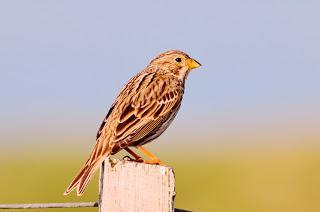
© SNH/Lorne Gill
The number of corn buntings has stabilised in Aberdeenshire and Moray, according to a Scottish Natural Heritage (SNH) report published today. Corn buntings are farmland birds which are at high risk in the UK after dramatic population declines and range contractions.Corn buntings are red-listed in the UK, which means they are considered the highest conservation priority with urgent action needed. Once widespread, the birds are now only found in four main areas of Scotland – Fife, Angus, the Western Isles and the stronghold of Aberdeenshire and Moray.There was a slight increase in corn bunting numbers across the 48 farms surveyed, with 246 territorial males in 2015, compared with 232 in 2008–09. This is in sharp contrast with severe, long-term decline across Scotland in the 1970s to 2000s.Jessica Shaw, SNH ornithologist, said:“It’s wonderful news that the number of corn buntings in Aberdeenshire and Moray has stabilised, with the good work done by many farmers in the area. But we can’t be complacent, as the population is still much lower than 20 years ago. We’re committed to working with farmers to increase the number of corn buntings in Scotland.”Allan Perkins, RSPB Scotland conservation scientist, said:"The results of the survey are very encouraging, and a reflection of the many years of partnership working with farmers in these areas to improve the fortunes of this fantastic bird. Corn buntings favour farmland which is managed less intensively, especially late-cut meadows and weedy cereal fields, along with a rich source of seeds and grain during winter. Government funding is available for this type of management, and we encourage more farmers to participate to help restore corn bunting numbers to what they were in the 1990s."An agri-environmental scheme (AES) package to support corn buntings was available for farmers from 2007 to 2013 through the Scottish Rural Development Programme (SDRP), with a new scheme in place from 2015-2020, the Agri-Environment Climate Scheme (AECS). There is a wealth of evidence showing SRDP is the best tool available to help the recovery of corn buntings, and the report emphasises the importance of keeping up the momentum of AES schemes, as well as improving results by targeting measures to benefit corn buntings even further.The current national population of corn buntings is estimated to be between 750 and 900 territorial males: this is 34 to 41% of the 2,200 estimated in 1993. The decline of corn buntings in Scotland and across much of Europe is mainly as a result of agricultural intensification.To see the full report, see http://www.snh.gov.uk/publications-data-and-research/publications/search-the-catalogue/publication-detail/?id=2452SNH is working on strengthening bird populations and biodiversity throughout Scotland. Restoring the corn bunting population is part of the Scottish Biodiversity Strategy Route Map published by Scottish Government in June 2015. The route map sets out the big steps needed to implement the Scottish Biodiversity Strategy 2020 Challenge, including restoring ecosystems, conserving wildlife, and sustainably managing land, freshwater and the marine environment. The SBS 2020 Challengeis Scotland’s response to the Aichi Targets set by the United Nations Convention on Biological Diversity calling for a step change in efforts to halt the loss of biodiversity and restore essential services that a healthy natural environment provides.
